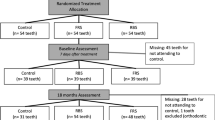Abstract
In 2007, the low shrinkage silorane-based composites with a completely new resin chemistry were introduced. As for the case of composite repair, the question of whether this new material class can be repaired with the same methods like dimethacrylate-based composites arises. The ability of a silorane-based composite (SBC) to be repaired was therefore examined in a shear-bond test. Specimens of SBC were polymerised, water-stored at 37°C for 1 week and then repaired with fresh dimethacrylate-based composite (MBC) or SBC material by using several intermediate agents (IMA). The shear-bond strength was then measured after an additional water storage of 1 week. As IMA, we tested an experimental silorane-flowable composite, two dimethacrylate-based flowable composites, a filled silorane system adhesive bond and a conventional unfilled adhesive, a silane in addition to an adhesive as well as a repair kit. Additionally, repairs of MBC with dimethacrylate-based flowable composite were prepared. Specimens of MBC and SBC bonded to dentine with the corresponding adhesives were used as a reference. The repairs of MBC with the flowable composite resin Tetric Evo Flow exhibited the highest mean repair bond strength value (42.2 MPa). For repair of SBC, the highest shear-bond strengths were measured for repairs using a silane additionally to a dimethacrylate-based adhesive resin, followed by repairs with the experimental silorane-based flowable composite resin Hermes Flow as IMA. SBC can be repaired in combination with a MBC; then a silane coupling agent plus a dimethacrylate-based IMA should be used. A silorane flowable as IMA is the best choice when SBC is to be repaired with SBC.



Similar content being viewed by others
References
Weinmann W, Thalacker C, Guggenberger R (2005) Siloranes in dental composites. Dent Mater 21:68–74
Tezvergil-Mutluay A, Lassila LVJ, Vallittu PK (2008) Incremental layers bonding of silorane composite: the initial bonding properties. J Dent 36:560–563
Lucena-Martin C, Gonzalez-Lopez S, Navajas-Rodriguez de Mondelo JM (2001) The effect of various surface treatments and bonding agents on the repaired strength of heat-treated composites. J Prosthet Dent 86:481–488
Brosh T, Pilo R, Bichacho N, Blutstein R (1997) Effect of combinations of surface treatments and bonding agents on the bond strength of repaired composites. J Prosthet Dent 77:122–126
Hannig C, Laubach S, Hahn P, Attin T (2006) Shear bond strength of repaired adhesive filling materials using different repair procedures. J Adhes Dent 8:35–40
Shahdad SA, Kennedy JG (1998) Bond strength of repaired anterior composite resins: an in vitro study. J Dent 26:685–694
Padipatvuthikul P, Mair LH (2007) Bonding of composite to water aged composite with surface treatments. Dent Mater 23:519–525
Söderholm KJ, Roberts MJ (1991) Variables influencing the repair strength of dental composites. Scand J Dent Res 99:173–180
Magni E, Ferrari M, Papacchini F, Hickel R, Ilie N (2010) Influence of ozone on the composite-to-composite bond. Clin Oral Investig 2010 Jan 7 (Epub ahead of print)
Junior SA, Ferracane JL, Bona AD (2008) Influence of surface treatments on the bond strength of repaired resin composite restorative materials. Dent Mater 25:442–451
Rinastiti M, Ozcan M, Siswomihardjo W, Busscher HJ (2010) Effects of surface conditioning on repair bond strengths of non-aged and aged microhybrid, nanohybrid, and nanofilled composite resins. Clin Oral Investig 2010 May 25 (Epub ahead of print) PMID: 20499119
Rathke A, Tymina Y, Haller B (2009) Effect of different surface treatments on the composite-composite repair bond strength. Clin Oral Investig 13:317–323
Frankenberger R, Kramer N, Ebert J, Lohbauer U, Kappel S, ten Weges S, Petschelt A (2003) Fatigue behavior of the resin-resin bond of partially replaced resin-based composite restorations. Am J Dent 16:17–22
Teixeira EC, Bayne SC, Thompson JY, Ritter AV, Swift EJ (2005) Shear bond strength of self-etching bonding systems in combination with various composites used for repairing aged composites. J Adhes Dent 7:159–164
Papacchini F, Dall’Oca S, Chieffi N, Goracci C, Sadek FT, Suh BI, Tay FR, Ferrari M (2007) Composite-to-composite microtensile bond strength in the repair of a microfilled hybrid resin: effect of surface treatment and oxygen inhibition. J Adhes Dent 9:25–31
Papacchini F, Radovic I, Magni E, Goracci C, Monticelli F, Chieffi N, Polimeni A, Ferrari M (2008) Flowable composites as intermediate agents without adhesive application in resin composite repair. Am J Dent 21:53–58
Shawkat ES, Shortall AC, Addison O, Palin WM (2009) Oxygen inhibition and incremental layer bond strengths of resin composites. Dent Mater 25:1338–1346
Ilie N, Jelen E, Clementino-Luedemann T, Hickel R (2007) Low-shrinkage composite for dental application. Dent Mater J 26:149–155
Ilie N, Hickel R (2006) Silorane-based dental composite: behavior and abilities. Dent Mater J 25:445–454
Moser S, Hickel R, Ilie N (2009) Strength of aged repairs made by silorane- and dimethacrylate-based composites. URL: http://iadr.confex.com/iadr/pef08/techprogram/abstract_111428.htm. Accessed 3 Jan 2009
Swift EJ Jr, Cloe BC, Boyer DB (1994) Effect of a silane coupling agent on composite repair strengths. Am J Dent 7:200–202
Moser S, Hickel R, Ilie N (2009) Are silorane compatible with dimethacrylate-based composites? doi:10.1016/j.dental.2009.01.026
Conflict of interest
The authors declare that they have no conflict of interest.
Author information
Authors and Affiliations
Corresponding author
Rights and permissions
About this article
Cite this article
Ivanovas, S., Hickel, R. & Ilie, N. How to repair fillings made by silorane-based composites. Clin Oral Invest 15, 915–922 (2011). https://doi.org/10.1007/s00784-010-0473-z
Received:
Accepted:
Published:
Issue Date:
DOI: https://doi.org/10.1007/s00784-010-0473-z




